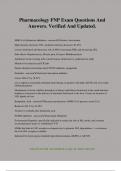Pharmacology FNP Exam Questions And
Answers. Verified And Updated.
HMG-CoA Reductase Inhibitors - answer✔✔(Statins) Atorvastatin
High intensity decreases 50%, moderate intensity decreases 30-49%
Lowers cholesterol and decreases risk of MI by increasing HDL and decreasing LDL.
Side effects: Hepatotoxicity, Muscle pain, GI upset, Rhabdomyolysis
Administer in the evening with a meal because cholesterol is synthesized at night
Monitor liver function and CK labs
Patient should avoid alcohol and CYP450 inhibitors (grapefruit)
Ezetimbe - answer✔✔cholesterol absorption inhibitor
lowers LDL-C by 18-23%
use as adjunt to maximally tolerated statin therapy in patients with high ASCVD risk or in statin
intolerant patients.
Mechanism of action: inhibits absorption of dietary and biliary cholesterol in the small intestine,
leading to a decrease in the delivery of intestinal cholesterol to the liver. Causes an increase of
LDL uptake in liver.
Bempedoic Acid - answer✔✔Decreases production of HMG-CoA precursr acetyl CoA.
Reduces LDL-C by 18-28%
Nexlizet is ezetimbe plus bempoedic acid
PCSK9 inhibitors - answer✔✔Alirocumab (Praluent)
Evolocumab (Repatha): specifically indicated to reduce the risk of MI, stroke, and coronary
revascularization in pts w/ established CVD
MABs that bind to LDL receptors on hepatocytes to promote LDL degradation--> so increases
the # of LDL receptors available
Indicated for heterozygous familial hypercholesterolemia (HeFH) or ASCVD
EXAM STUDY MATERIALS July 25, 2024 1:06 PM
,Use for high risk ASCVD and elevated LDL despite max statin therapy for additional LDL
reduction
Icosapent ethyl (Vascepa) - answer✔✔Another option reducing ASCVD risk when on max
statin. Has been shown to reduce morbidity and mortality in CVA. reduces triglycerides not LDL
not USED FOR LOWERING LDL
used to treat severe hypertriglyceridemia; exact MOA unknown; reduces hepatic triglyceride
synthesis
Use when patients have DM and two other risk factors for ASCVD or with multiple ASCVD
events
best if triglycerides >135
Niacin - answer✔✔Vitamin B3, inhibits release of free fatty acids from adipose tissue
Increases rate of triglyceride removal from plasma
Fibrates - answer✔✔gemfibrozil, fenofibrate, fenofibric acid
Decrease triglycerides by 20-50% particularly useful in treating type III hyperlipidemia in which
I-LDL accumulates
Bile Acid Sequestrants - answer✔✔Cholestyramine, colestipol, colesevelam
1. Mech: *prevent intestinal absorption of bile acids* -> bile excretion -> *liver depletes LDL
cholesterol stores* to synthesize more bile acids
-*Must co-administer with statin* (prevents compensatory inc. in LDL cholesterol synthesis by
the liver)
2. Clinical: decreases LDL
3. Toxicity:
-*Tastes bad*, GI discomfort
-*Dec. absorption of fat-soluble vitamins, hyperTGemia*
-*Cholesterol gallstones* (inc. risk w/fibrates)
omega-3 fatty acids - answer✔✔polyunsaturated fatty acids commonly found in fish oils that are
beneficial to cardiovascular health
EXAM STUDY MATERIALS July 25, 2024 1:06 PM
,Inhibit VLDL and triglyceride synthesis in the liver
4g of EPA an DHA decrease triglycerides by 25%-30%
Diuretics - answer✔✔ion transport inhibitors NOT WATER TRANSPORT INHIBITORS
impact absorption of electrolytes
as osmolarity of urine decreases water will move into the tubule to maintain osmotic pressure
gradient
Thiazide - answer✔✔HCTZ (hydrochlorothiazide)
distal convoluted tubule in the lumin, less water excretion than Loop.
Only class that works in the lumin: SO requires adequate renal perfusion GFR >30
Primary drug for cardiovascular disorders
ASE: electrolyte imbalance, hyponatremia, uric acid retention, potentiate drugs with ototoxicity
and nephrotoxicity.
Contraindicated: Gout
Labs: electrolytes, hyponatremia/chloremia (especially elderly), hyperkalemia, renal function,
BUN/Cr & uric acid
- most people will have hyponatremia that resolves after a week
Loop diuretics - answer✔✔furosemide, bumetanide, torsemide
Proximal convoluted tubule more water excretion
Potassium sparing diuretics - answer✔✔Spironolactone (Aldactone)
most distal part of distal tubule and least amount of water excretion
Beta-adrenergic blockers - answer✔✔Olol medications
Reduce blood pressure by decreasing cardiac output. prevents sympathetic stimulation of the
heart, prevents renin release from kidney, resulting in less outflow and less water retention in the
kidney.
B1= cardiac muscle, increase contractility
B2= relax smooth muscle, especially in lung
EXAM STUDY MATERIALS July 25, 2024 1:06 PM
, 3. Indernal (Propranolol) non-selective beta blocker
4. Tenormin (atenolol) selective beta blocker
5. Lopressor (metoprolol) selective beta blocker
Third generation combo drugs:
Nebivolol (Bystolic): 5-20mg/d BB (very cardio selective) plus nitrate- only approved for HTN
Carvediliol (Coreg): 3.125 to 25mg BID. BB (non cardio selective) and Alpha blocker. indicated
for CHF, HTN and LV dysfunction after MI
Avoid epinephrine with non-selective beta blockers
AE: brady, hypotension, CHF (interesting because we use it for CHF, but if CHF is so profound
it will make worse). B2 receptor blocker SE: bronchospasm, inability to present sympathetic
response, fatigue, ED
Contraindications: sinus brady, heart block>1st degree, RAD, anticholinergics increase
absorption (GI motility slowed)
beta receptors - answer✔✔adrenergic receptors that are found in the heart, lungs, and vascular
smooth muscle
alpha receptors - answer✔✔stimulated by epinephrine and norepinephrine
Found in smooth muscles in arteries
Alpha Adrenergic Blockers - answer✔✔Relax certain muscles and help small blood vessels
remain open. They work by keeping the hormone norepinephrine from tightening the muscles in
the walls of smaller arteries and veins. Blocking that effect causes the vessels to remain open and
relaxed. This improves blood flow and lowers BP.
More old school drugs. now use for night terrors
Prazosin (Minipress)
Tetrazosin (Hytrin)
EXAM STUDY MATERIALS July 25, 2024 1:06 PM




